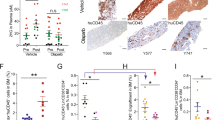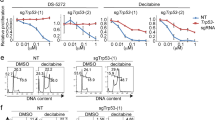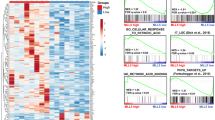Abstract
Suppression of apoptosis by TP53 mutation contributes to resistance of acute myeloid leukemia (AML) to conventional cytotoxic treatment. Using differentiation to induce irreversible cell cycle exit in AML cells could be a p53-independent treatment alternative, however, this possibility requires evaluation. In vitro and in vivo regimens of the deoxycytidine analogue decitabine that deplete the chromatin-modifying enzyme DNA methyl-transferase 1 without phosphorylating p53 or inducing early apoptosis were determined. These decitabine regimens but not equimolar DNA-damaging cytarabine upregulated the key late differentiation factors CCAAT enhancer-binding protein ɛ and p27/cyclin dependent kinase inhibitor 1B (CDKN1B), induced cellular differentiation and terminated AML cell cycle, even in cytarabine-resistant p53- and p16/CDKN2A-null AML cells. Leukemia initiation by xenotransplanted AML cells was abrogated but normal hematopoietic stem cell engraftment was preserved. In vivo, the low toxicity allowed frequent drug administration to increase exposure, an important consideration for S phase specific decitabine therapy. In xenotransplant models of p53-null and relapsed/refractory AML, the non-cytotoxic regimen significantly extended survival compared with conventional cytotoxic cytarabine. Modifying in vivo dose and schedule to emphasize this pathway of decitabine action can bypass a mechanism of resistance to standard therapy.
This is a preview of subscription content, access via your institution
Access options
Subscribe to this journal
Receive 12 print issues and online access
$259.00 per year
only $21.58 per issue
Buy this article
- Purchase on Springer Link
- Instant access to full article PDF
Prices may be subject to local taxes which are calculated during checkout






Similar content being viewed by others
References
Vazquez A, Bond EE, Levine AJ, Bond GL . The genetics of the p53 pathway, apoptosis and cancer therapy. Nat Rev Drug Discov 2008; 7: 979–987.
Suarez L, Vidriales MB, Garcia-Larana J, Sanz G, Moreno MJ, Lopez A et al. CD34+ cells from acute myeloid leukemia, myelodysplastic syndromes, and normal bone marrow display different apoptosis and drug resistance-associated phenotypes. Clin Cancer Res 2004; 10: 7599–7606.
Yin B, Kogan SC, Dickins RA, Lowe SW, Largaespada DA . Trp53 loss during in vitro selection contributes to acquired Ara-C resistance in acute myeloid leukemia. Exp Hematol 2006; 34: 631–641.
Wattel E, Preudhomme C, Hecquet B, Vanrumbeke M, Quesnel B, Dervite I et al. p53 mutations are associated with resistance to chemotherapy and short survival in hematologic malignancies. Blood 1994; 84: 3148–3157.
Toledo F, Wahl GM . Regulating the p53 pathway: in vitro hypotheses, in vivo veritas. Nat Rev Cancer 2006; 6: 909–923.
Harutyunyan A, Klampfl T, Cazzola M, Kralovics R . p53 lesions in leukemic transformation. N Engl J Med 2011; 364: 488–490.
Haferlach C, Dicker F, Herholz H, Schnittger S, Kern W, Haferlach T . Mutations of the TP53 gene in acute myeloid leukemia are strongly associated with a complex aberrant karyotype. Leukemia 2008; 22: 1539–1541.
Attardi LD, Donehower LA . Probing p53 biological functions through the use of genetically engineered mouse models. Mutat Res 2005; 576: 4–21.
PIERCE Jr GB, VERNEY EL . An in vitro and in vivo study of differentiation in teratocarcinomas. Cancer 1961; 14: 1017–1029.
Michalewicz R, Lotem J, Sachs L . Cell differentiation and therapeutic effect of low doses of cytosine arabinoside in human myeloid leukemia. Leuk Res 1984; 8: 783–790.
Seilern-Aspang F, Kratochwil K . Induction and differentiation of an epithelial tumour in the newt (Triturus cristatus). J Embryol Exp Morphol 1962; 10: 337–356.
Jones PA, Taylor SM . Cellular differentiation, cytidine analogs and DNA methylation. Cell 1980; 20: 85–93.
Pinto A, Attadia V, Fusco A, Ferrara F, Spada OA, Di Fiore PP . 5-Aza-2′-deoxycytidine induces terminal differentiation of leukemic blasts from patients with acute myeloid leukemias. Blood 1984; 64: 922–929.
Creusot F, Acs G, Christman JK . Inhibition of DNA methyltransferase and induction of Friend erythroleukemia cell differentiation by 5-azacytidine and 5-aza-2′-deoxycytidine. J Biol Chem 1982; 257: 2041–2048.
Nowak D, Stewart D, Koeffler HP . Differentiation therapy of leukemia: 3 decades of development. Blood 2009; 113: 3655–3665.
Niitsu N, Hayashi Y, Sugita K, Honma Y . Sensitization by 5-aza-2′-deoxycytidine of leukaemia cells with MLL abnormalities to induction of differentiation by all-trans retinoic acid and 1alpha,25-dihydroxyvitamin D3. Br J Haematol 2001; 112: 315–326.
Kosugi H, Towatari M, Hatano S, Kitamura K, Kiyoi H, Kinoshita T et al. Histone deacetylase inhibitors are the potent inducer/enhancer of differentiation in acute myeloid leukemia: a new approach to anti-leukemia therapy. Leukemia 1999; 13: 1316–1324.
Wang J, Saunthararajah Y, Redner RL, Liu JM . Inhibitors of histone deacetylase relieve ETO-mediated repression and induce differentiation of AML1-ETO leukemia cells. Cancer Res 1999; 59: 2766–2769.
Schmelz K, Wagner M, Dorken B, Tamm I . 5-Aza-2′-deoxycytidine induces p21WAF expression by demethylation of p73 leading to p53-independent apoptosis in myeloid leukemia. Int J Cancer 2005; 114: 683–695.
Tuma RS . Epigenetic therapies move into new territory, but how exactly do they work? J Natl Cancer Inst 2009; 101: 1300–1301.
Covey JM, D’Incalci M, Tilchen EJ, Zaharko DS, Kohn KW . Differences in DNA damage produced by incorporation of 5-aza-2′-deoxycytidine or 5,6-dihydro-5-azacytidine into DNA of mammalian cells. Cancer Res 1986; 46: 5511–5517.
Schermelleh L, Haemmer A, Spada F, Rosing N, Meilinger D, Rothbauer U et al. Dynamics of Dnmt1 interaction with the replication machinery and its role in postreplicative maintenance of DNA methylation. Nucleic Acids Res 2007; 35: 4301–4312.
Momparler RL, Goodman J . In vitro cytotoxic and biochemical effects of 5-aza-2′-deoxycytidine. Cancer Res 1977; 37: 1636–1639.
Halaban R, Krauthammer M, Pelizzola M, Cheng E, Kovacs D, Sznol M et al. Integrative analysis of epigenetic modulation in melanoma cell response to decitabine: clinical implications. PLoS ONE 2009; 4: e4563.
Saunthararajah Y, Hillery CA, Lavelle D, Molokie R, Dorn L, Bressler L et al. Effects of 5-aza-2′-deoxycytidine on fetal hemoglobin levels, red cell adhesion, and hematopoietic differentiation in patients with sickle cell disease. Blood 2003; 102: 3865–3870.
Milhem M, Mahmud N, Lavelle D, Araki H, Desimone J, Saunthararajah Y et al. Modification of hematopoietic stem cell fate by 5aza 2′deoxycytidine and trichostatin A. Blood 2004; 103: 4102–4110.
Araki H, Yoshinaga K, Boccuni P, Zhao Y, Hoffman R, Mahmud N . Chromatin-modifying agents permit human hematopoietic stem cells to undergo multiple cell divisions while retaining their repopulating potential. Blood 2007; 109: 3570–3578.
Suzuki M, Harashima A, Okochi A, Yamamoto M, Nakamura S, Motoda R et al. 5-Azacytidine supports the long-term repopulating activity of cord blood CD34(+) cells. Am J Hematol 2004; 77: 313–315.
Chung YS, Kim HJ, Kim TM, Hong SH, Kwon KR, An S et al. Undifferentiated hematopoietic cells are characterized by a genome-wide undermethylation dip around the transcription start site and a hierarchical epigenetic plasticity. Blood 2009; 114: 4968–4978.
Fero ML, Rivkin M, Tasch M, Porter P, Carow CE, Firpo E et al. A syndrome of multiorgan hyperplasia with features of gigantism, tumorigenesis, and female sterility in p27(Kip1)-deficient mice. Cell 1996; 85: 733–744.
Kiyokawa H, Kineman RD, Manova-Todorova KO, Soares VC, Hoffman ES, Ono M et al. Enhanced growth of mice lacking the cyclin-dependent kinase inhibitor function of p27(Kip1). Cell 1996; 85: 721–732.
Nakayama K, Ishida N, Shirane M, Inomata A, Inoue T, Shishido N et al. Mice lacking p27(Kip1) display increased body size, multiple organ hyperplasia, retinal dysplasia, and pituitary tumors. Cell 1996; 85: 707–720.
Furukawa Y, Kikuchi J, Nakamura M, Iwase S, Yamada H, Matsuda M . Lineage-specific regulation of cell cycle control gene expression during haematopoietic cell differentiation. Br J Haematol 2000; 110: 663–673.
Wei J, Wunderlich M, Fox C, Alvarez S, Cigudosa JC, Wilhelm JS et al. Microenvironment determines lineage fate in a human model of MLL-AF9 leukemia. Cancer Cell 2008; 13: 483–495.
Liu Z, Marcucci G, Byrd JC, Grever M, Xiao J, Chan KK . Characterization of decomposition products and preclinical and low dose clinical pharmacokinetics of decitabine (5-aza-2′-deoxycytidine) by a new liquid chromatography/tandem mass spectrometry quantification method. Rapid Commun Mass Spectrom 2006; 20: 1117–1126.
Rogstad DK, Herring JL, Theruvathu JA, Burdzy A, Perry CC, Neidigh JW et al. Chemical decomposition of 5-aza-2′-deoxycytidine (Decitabine): kinetic analyses and identification of products by NMR, HPLC, and mass spectrometry. Chem Res Toxicol 2009; 22: 1194–1204.
Lee JK, Havaleshko DM, Cho H, Weinstein JN, Kaldjian EP, Karpovich J et al. A strategy for predicting the chemosensitivity of human cancers and its application to drug discovery. Proc Natl Acad Sci USA 2007; 104: 13086–13091.
Odero MD, Zeleznik L, Chinwalla V, Rowley JD . Cytogenetic and molecular analysis of the acute monocytic leukemia cell line THP-1 with an MLL-AF9 translocation. Genes Chromosomes Cancer 2000; 29: 333–338.
Kim WY, Sharpless NE . The regulation of INK4/ARF in cancer and aging. Cell 2006; 127: 265–275.
Iwasaki H, Akashi K . Myeloid lineage commitment from the hematopoietic stem cell. Immunity 2007; 26: 726–740.
Yamanaka R, Barlow C, Lekstrom-Himes J, Castilla LH, Liu PP, Eckhaus M et al. Impaired granulopoiesis, myelodysplasia, and early lethality in CCAAT/enhancer binding protein epsilon-deficient mice. Proc Natl Acad Sci USA 1997; 94: 13187–13192.
Theilgaard-Monch K, Jacobsen LC, Borup R, Rasmussen T, Bjerregaard MD, Nielsen FC et al. The transcriptional program of terminal granulocytic differentiation. Blood 2005; 105: 1785–1796.
Truong BT, Lee YJ, Lodie TA, Park DJ, Perrotti D, Watanabe N et al. CCAAT/Enhancer binding proteins repress the leukemic phenotype of acute myeloid leukemia. Blood 2003; 101: 1141–1148.
Agrawal S, Hofmann WK, Tidow N, Ehrich M, van den BD, Koschmieder S et al. The C/EBPdelta tumor suppressor is silenced by hypermethylation in acute myeloid leukemia. Blood 2007; 109: 3895–3905.
Hsieh FF, Barnett LA, Green WF, Freedman K, Matushansky I, Skoultchi AI et al. Cell cycle exit during terminal erythroid differentiation is associated with accumulation of p27(Kip1) and inactivation of cdk2 kinase. Blood 2000; 96: 2746–2754.
Sakashita K, Koike K, Kinoshita T, Shiohara M, Kamijo T, Taniguchi S et al. Dynamic DNA methylation change in the CpG island region of p15 during human myeloid development. J Clin Invest 2001; 108: 1195–1204.
Kamel-Reid S, Dick JE . Engraftment of immune-deficient mice with human hematopoietic stem cells. Science 1988; 242: 1706–1709.
Lapidot T, Sirard C, Vormoor J, Murdoch B, Hoang T, Caceres-Cortes J et al. A cell initiating human acute myeloid leukaemia after transplantation into SCID mice. Nature 1994; 367: 645–648.
Hollenbach PW, Nguyen AN, Brady H, Williams M, Ning Y, Richard N et al. A comparison of azacitidine and decitabine activities in acute myeloid leukemia cell lines. PLoS One 2010; 5: e9001.
Guo Y, Engelhardt M, Wider D, Abdelkarim M, Lubbert M . Effects of 5-aza-2′-deoxycytidine on proliferation, differentiation and p15/INK4b regulation of human hematopoietic progenitor cells. Leukemia 2006; 20: 115–121.
Zuber J, Radtke I, Pardee TS, Zhao Z, Rappaport AR, Luo W et al. Mouse models of human AML accurately predict chemotherapy response. Genes Dev 2009; 23: 877–889.
Hu Z, Negrotto S, Gu X, Mahfouz R, Ng KP, Ebrahem Q et al. Decitabine maintains hematopoietic precursor self-renewal by preventing repression of stem cell genes by a differentiation-inducing stimulus. Mol Cancer Ther 2010; 9: 1536–1543.
Dick JE . Stem cell concepts renew cancer research. Blood 2008; 112: 4793–4807.
Taussig DC, Miraki-Moud F, Anjos-Afonso F, Pearce DJ, Allen K, Ridler C et al. Anti-CD38 antibody-mediated clearance of human repopulating cells masks the heterogeneity of leukemia-initiating cells. Blood 2008; 112: 568–575.
Kirstetter P, Schuster MB, Bereshchenko O, Moore S, Dvinge H, Kurz E et al. Modeling of C/EBPalpha mutant acute myeloid leukemia reveals a common expression signature of committed myeloid leukemia-initiating cells. Cancer Cell 2008; 13: 299–310.
Huntly BJ, Shigematsu H, Deguchi K, Lee BH, Mizuno S, Duclos N et al. MOZ-TIF2, but not BCR-ABL, confers properties of leukemic stem cells to committed murine hematopoietic progenitors. Cancer Cell 2004; 6: 587–596.
Somervaille TC, Cleary ML . Identification and characterization of leukemia stem cells in murine MLL-AF9 acute myeloid leukemia. Cancer Cell 2006; 10: 257–268.
van Rhenen A, Moshaver B, Kelder A, Feller N, Nieuwint AW, Zweegman S et al. Aberrant marker expression patterns on the CD34+. Leukemia 2007; 21: 1700–1707.
Blair A, Hogge DE, Ailles LE, Lansdorp PM, Sutherland HJ . Lack of expression of Thy-1 (CD90) on acute myeloid leukemia cells with long-term proliferative ability in vitro and in vivo. Blood 1997; 89: 3104–3112.
Blair A, Sutherland HJ . Primitive acute myeloid leukemia cells with long-term proliferative ability in vitro and in vivo lack surface expression of c-kit (CD117). Exp Hematol 2000; 28: 660–671.
Feuring-Buske M, Gerhard B, Cashman J, Humphries RK, Eaves CJ, Hogge DE . Improved engraftment of human acute myeloid leukemia progenitor cells in beta 2-microglobulin-deficient NOD/SCID mice and in NOD/SCID mice transgenic for human growth factors. Leukemia 2003; 17: 760–763.
Wunderlich M, Chou FS, Link KA, Mizukawa B, Perry RL, Carroll M et al. AML xenograft efficiency is significantly improved in NOD/SCID-IL2RG mice constitutively expressing human SCF, GM-CSF and IL-3. Leukemia 2010; 24: 1785–1788.
Agliano A, Martin-Padura I, Mancuso P, Marighetti P, Rabascio C, Pruneri G et al. Human acute leukemia cells injected in NOD/LtSz-scid/IL-2Rgamma null mice generate a faster and more efficient disease compared to other NOD/scid-related strains. Int J Cancer 2008; 123: 2222–2227.
Rivard GE, Momparler RL, Demers J, Benoit P, Raymond R, Lin K et al. Phase I study on 5-aza-2′-deoxycytidine in children with acute leukemia. Leuk Res 1981; 5: 453–462.
Sorm F, Vesely J . Effect of 5-aza-2′-deoxycytidine against leukemic and hemopoietic tissues in AKR mice. Neoplasma 1968; 15: 339–343.
Farinha NJ, Shaker S, Lemaire M, Momparler L, Bernstein M, Momparler RL . Activation of expression of p15, p73 and E-cadherin in leukemic cells by different concentrations of 5-aza-2′-deoxycytidine (decitabine). Anticancer Res 2004; 24: 75–78.
Jiemjit A, Fandy TE, Carraway H, Bailey KA, Baylin S, Herman JG et al. p21(WAF1/CIP1) induction by 5-azacytosine nucleosides requires DNA damage. Oncogene 2008; 27: 3615–3623.
Raj K, John A, Ho A, Chronis C, Khan S, Samuel J et al. CDKN2B methylation status and isolated chromosome 7 abnormalities predict responses to treatment with 5-azacytidine. Leukemia 2007; 21: 1937–1944.
Kantarjian H, Oki Y, Garcia-Manero G, Huang X, O’Brien S, Cortes J et al. Results of a randomized study of 3 schedules of low-dose decitabine in higher-risk myelodysplastic syndrome and chronic myelomonocytic leukemia. Blood 2007; 109: 52–57.
Steensma DP, Baer MR, Slack JL, Buckstein R, Godley LA, Garcia-Manero G et al. Multicenter study of decitabine administered daily for 5 days every 4 weeks to adults with myelodysplastic syndromes: the alternative dosing for outpatient treatment (ADOPT) trial. J Clin Oncol 2009; 27: 3842–3848.
Acknowledgements
We gratefully acknowledge the following gifts: Mary Laughlin and Nick Greco at the Abraham J and Phyllis Katz Cord Blood Foundation and Cleveland Cord Blood Center for cord blood samples; YS is supported by NIH (1R01CA138858, U54HL090513) and Department of Defense (PR081404). KPN and YS are supported by Scott Hamilton CARES Foundation.
Author information
Authors and Affiliations
Corresponding author
Ethics declarations
Competing interests
The authors declare no conflict of interest.
Additional information
Supplementary Information accompanies the paper on the Leukemia website
Rights and permissions
About this article
Cite this article
Ng, K., Ebrahem, Q., Negrotto, S. et al. p53 Independent epigenetic-differentiation treatment in xenotransplant models of acute myeloid leukemia. Leukemia 25, 1739–1750 (2011). https://doi.org/10.1038/leu.2011.159
Received:
Revised:
Accepted:
Published:
Issue Date:
DOI: https://doi.org/10.1038/leu.2011.159
Keywords
This article is cited by
-
Decitabine- and 5-azacytidine resistance emerges from adaptive responses of the pyrimidine metabolism network
Leukemia (2021)
-
Role Of TP53 mutations in predicting the clinical efficacy of hypomethylating therapy in patients with myelodysplastic syndrome and related neoplasms: a systematic review and meta-analysis
Clinical and Experimental Medicine (2020)
-
Opposing effects of acute versus chronic inhibition of p53 on decitabine’s efficacy in myeloid neoplasms
Scientific Reports (2019)
-
Tracking Decitabine Incorporation into Malignant Myeloid Cell DNA in vitro and in vivo by LC-MS/MS with Enzymatic Digestion
Scientific Reports (2019)
-
Differentiation therapy and the mechanisms that terminate cancer cell proliferation without harming normal cells
Cell Death & Disease (2018)



